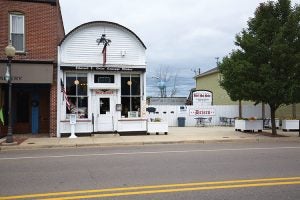Visiting downtown Three Oaks can feel a bit like stepping onto a movie set.
Rustic-looking brick buildings border either side of the Main Street, where a theater, pizza shop and longstanding butcher shop are housed, rounding out a signature small-town character that can be hard to find.
Picture the tiny street decorated in Christmas lights and veiled with snow and the idyllic backdrop seems picture perfect for a holiday movie.
 That’s probably why Director John D. Hancock, 79, chose to use Three Oaks to create a setting for “Prancer” nearly 30 years ago.
That’s probably why Director John D. Hancock, 79, chose to use Three Oaks to create a setting for “Prancer” nearly 30 years ago.
Hancock also has a special connection to Michigan and Indiana. He remembered the small-town charm from his days growing up in the area and he chose to use Three Oaks and LaPorte, Indiana. This year the movie celebrates its 29th anniversary and its creation has remained a memorable event to Three Oaks residents.
Hancock said he did not immediately identify the Michigan and Indiana area as the ideal setting for the movie. In fact, he and producer Raffaella De Laurentiis scouted towns in Canada and Vermont in search of the very character that Three Oaks possesses.
While he grew up in the western suburbs of Chicago, John’s family owned a fruit farm in LaPorte and he spent a number of weekends and long summer days in the Michiana area. He recalled trips to Three Oaks with his grandfather, where the pair would visit Drier’s Meat Market, traversing the sawdust-covered floor to purchase links of German sausage. Thinking back on these childhood memories, John says he was moved to bring the movie to Three Oaks.
“I liked the railroad. I liked the classic American Main Street,” John says. “I liked the memories it evoked in me of being a child of that age.”
“Prancer” was released Nov. 17, 1989. The holiday movie starred Rebecca Harrell, who played inquisitive and strong-willed 8-year-old Jessica Riggs. Jessica lives on an apple orchard in Three Oaks with her older brother and widowed father.
While walking home from school one day, Jessica stumbles on an injured reindeer. Convinced that the reindeer is Prancer from Santa’s fleet, she seeks to nurse him back to health, while also trying to keep her mission a secret.
Things go awry when word gets out through the newspaper and Prancer is bought by a local butcher, who decides to put Prancer on display (the butcher shop used in the film is the very place where Hancock used to spend time with his grandfather). Banding together, the townsfolk take heart in Riggs’ mission and decide to help her return Prancer to his rightful owner.
John saw an opportunity to not only pay homage to his childhood haven, but also get the local people of Three Oaks involved in the movie. He allowed a number of them to be extras and even gave some of them lines. At the end of a day of shooting, actors and residents would mingle.
“A lot of them appear in it [“Prancer”],” John says. “It meant a lot to the people. Sam Elliot [the actor who played Jessica’s father, John] was real chatty with people in bars at night. The cast was good with the town and the town with them. People enjoyed it.”
As for the scenes on the apple farm, those were shot on John’s own family farm in LaPorte.
“That’s our barn, our orchard, our house,” John says. “I found it very satisfying to direct something where I grew up.”
Some scenes were also filmed in Starved Rock State Park in Utica, Illinois.
The movie was filmed in January and to spare actors from the biting winter cold, some night scenes in the movie were filmed in a warehouse. Three Oaks’ Main Street was duplicated as a set piece.
John studied English at Harvard University and got some of his earliest experience in the field directing theater while he was an undergraduate. Today, he has about 60 years of experience in directing. He has also written and produced his own work.
John believes the movie helped to bring some notoriety to Three Oaks. The movie also became the first of many of the director’s works to be filmed in and around the Michigan and Indiana area, including, “Piece of Eden,” “Suspended Animation,” “The Looking Glass” and a soon-to-be released moved called, “The Girls of Summer.”
Today, John resides in the LaPorte area where he continues to look for inspiration.
“I really found it satisfying because I have come back over and over,” he says.
Photos by Ann Reiff





